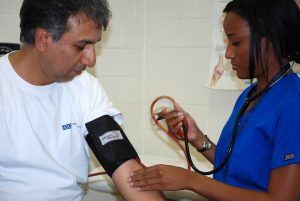
The Medical Assisting program provides learning opportunities which introduce, develop, and reinforce academic and occupational knowledge, skills, and attitudes required for job acquisition, retention, and advancement. Additionally, the program provides opportunities to upgrade present knowledge and skills or to retrain in the area of medical assisting. Graduates of the program receive a Medical Assisting diploma.
The Medical Assisting Program is accredited by the Commission on Accreditation of Allied Health Education Programs (www.caahep.org) upon the recommendation of Medical Assisting Education Review Board (MAERB). The program is fully accredited until May 2026.
Commission on Accreditation of Allied Health Education Programs 25400 US Highway 19 N., Suite 158 Clearwater, FL 33763 727-210-2350 www.caahep.org
What skills do students learn in the program?
Medical assistants are the only allied health professional trained to work in ambulatory care (outpatient) settings. They are multi-skilled healthcare workers trained in both administrative and clinical duties.
Administrative duties:
- Using computer applications and handling correspondence, billing and bookkeeping
- Answering telephones, welcoming patients and scheduling appointments
- Communicating professionally with patients, family members and practitioners
- HIPPA and facility safety compliance
- Updating and filing patient medical health records and coding and completing insurance forms
- Arranging for hospital admissions and laboratory services
- Performing patient education, coaching and performing within scope of practice
Clinical duties:
- Taking medical histories and vital signs and preparing patients for examinations
- Explaining treatment procedures to patients and instructing them about medication and special diets
- Assisting the physician during examinations and minor surgical procedures
- Performing First Aid procedures, wound care and changing dressings as needed
- Collecting and preparing laboratory specimens and performing basic laboratory tests
- Preparing and administering medications as directed by a physician or other licensed provider (i.e. a nurse practitioner or physician assistant)
- Transmitting prescription refills as directed
- Taking electrocardiograms
- Following OSHA/CDC guidelines for infection control
OCCUPATIONAL RISKS
Medical Assisting is a profession with many rewards, as practitioners can perform both administrative and clinical services, filling several roles in a variety of healthcare environments. The Bureau of Labor Statistics clearly outlines that it is a growth field, with an anticipated 18% growth from 2020 to 2030. Medical Assistants work directly with providers and patients, with the goal of providing healthcare and ensuring patient safety. It is a position with a great deal of responsibility.
As with any healthcare position, there are certain occupational risks that come into play with being a medical assistant, and those hazards include the following:
- Exposure to infectious diseases
- Sharps injuries
- Bloodborne pathogens and biological hazards
- Chemical and drug exposure
- Ergonomic hazards from lifting, sitting, and repetitive tasks (ex: lower back problems)
- Latex allergies
- Stress and/or burnout
At the same time, there are protections set up with the Occupational Safety and Health Act (OSHA), and those protections are particularly important within a healthcare environment. OSHA has a series of standards that protect the safety of healthcare workers and patients.
Accredited medical assisting programs are required to teach students about the hazards that they face on the job and the protocols that can be put into place to ensure a workplace culture that prioritizes safety.
Patient Liaison: Medical assistants are instrumental in helping patients feel at ease in the physician’s office and often explain the physician’s instructions.
Patient-centered medical home (PCMH) Team Member: Medical assistants are essential members of the PCMH team. According to a survey by the Healthcare Intelligence Network, medical assistants ranked as one of the top five professionals necessary to the PCMH team.
What types of students thrive in the program and in this career field? Those who:
- like to work with patients and are caring and compassionate
- prefer ambulatory (outpatient) care settings
- enjoy performing hands-on work
- enjoy computers and office work
What types of jobs are available to graduates of this program? Where can they work?
- Group practices, outpatient centers and ambulatory care, physician offices (family practice, internal medicine, pediatrics, urology, GI, OB/GYN, orthopedics, etc). Some county health departments and chiropractic clinics also utilize medical assistants.
CMA (AAMA)® Certification: Many employers of allied health personnel prefer, or even insist, that their medical assistants are CMA (AAMA) certified.
The American Association of Medical Assistants (AAMA) offers certification to graduates of medical assisting programs accredited by the Commission on Accreditation of Allied Health Education Programs (CAAHEP) or the Accrediting Bureau of Health Education Schools (ABHES).
- GPTC students can apply for certification from the American Association of Medical Assistants CMA (AAMA) or the American Medical Technologist RMA (AMT)
